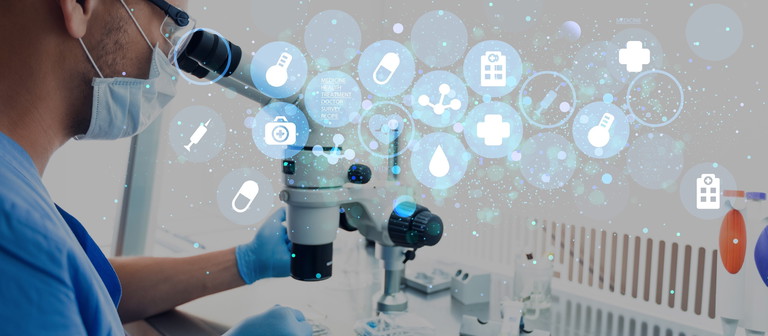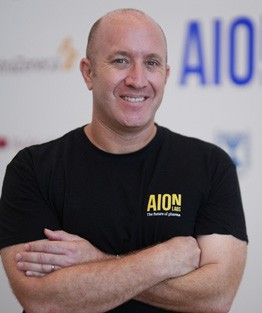Digital: AI in DD&D
Proving value in the age of drug discovery transformation
How is artificial intelligence changing the way drug discovery and development is enacted across the sector, yielding not only impressive potential, but also clinically validated pharma products?
Mati Gill at AION Labs
The artificial intelligence (AI) revolution in drug discovery has reached a moment of reckoning. Following years of bold forecasts and significant venture capital investment, the field now enters its most consequential phase: demonstrating that AI can yield not only potential, but regulator-endorsed, clinically validated therapeutics.
This transition from excitement to execution parallels the trajectory of the Gartner Hype Cycle, yet with far greater consequence. The technologies and companies that endure this maturation process will not simply improve how we discover drugs – they will reshape the very architecture of pharmaceutical innovation for the decade ahead.
Three forces are converging to define this shift: the clinical advancement of AI-designed molecules through human trials; the rapid acceleration of industry adoption through strategic partnerships and consolidation; and the emergence of regulatory frameworks that establish credible pathways for AI-augmented drug development.
Beyond the funding frenzy
Investment trends illustrate an industry recalibrating. Between 2019 and 2022, venture capital into AI-enabled drug discovery soared, with several rounds exceeding $100m.1 By mid-2023, however, both investor sentiment and public discourse had turned, shifting from algorithmic optimism to evidence-based scrutiny. This was not a collapse but a natural evolution. As James Royal-Lawson’s interpretation of the Gartner model suggests, only a minority of hyped technologies become truly transformative.2 The rest fade quietly or vanish altogether. What distinguishes the survivors is foundational: they are AI-native by design, not by retrofit.
Consider Exscientia, which accelerated AI-designed molecules into human trials in just 12-18 months – a fraction of the conventional four-to-six-year timeline.3 DSP-1181, developed entirely via AI for obsessive-compulsive disorder, entered phase 1 trials in 2020, becoming one of the first molecules fully conceived by algorithms to reach human testing.
Similarly, Hong Kong-based Insilico Medicine has demonstrated the accelerated potential of AI-driven development, advancing from target identification to preclinical trials in just 18 months, which is significantly faster than classical non-AI routes.4 The company now boasts phase 2 AI-based assets alongside a robust phase 1 pipeline, representing some of the most advanced AI-derived therapeutics in clinical development.
The full-stack revolution
AI-native biotechs mark a fundamental departure from traditional approaches. Rather than layering AI onto legacy workflows, companies such as Recursion, Insitro and Generate Biomedicines are engineering full-stack platforms that apply AI across the entire drug discovery life cycle, from target identification to trial design.
Recursion’s model epitomises this integration. It combines automated experimentation, computer vision and machine learning (ML) to build what it calls ‘one of the world’s largest proprietary biological data sets’. This is not mere data accumulation, but systematic biological inquiry at an unparalleled scale – over four petabytes of indexed, searchable insights.
Similarly, Generate Biomedicines employs generative AI to design novel proteins and antibodies. Its pipeline already includes clinical candidates, such as GB-0139, a computationally designed cytokine for cancer immunotherapy that entered human trials in 2024.
This architecture shift aligns with a growing consensus: 80% of pharmaceutical executives believe external innovation will be essential to future pipeline growth, according to McKinsey’s 2023 analysis.5 AI-native start-ups are rapidly becoming central to this external R&D strategy.
The field is also evolving toward domain-specific specialisation. DenovAI pioneers de novo antibody design targeting unique epitopes through computational biophysics. ProPhet leverages diffusion models and large language models to discover small molecules for proteins with sparse structural data. TenAces focuses on AI-designed molecular glue therapies for targeted protein degradation, while Promise Bio applies epiproteomic insights to advance precision therapies for autoimmune conditions. Together, these developments mark a shift from broad platforms to precision-engineered solutions.
Regulatory reality check
Ultimately, clinical validation must translate into regulatory acceptance. On this front, the US Food and Drug Administration (FDA) has signalled measured optimism, coupled with firm expectations for scientific transparency and methodological rigour. By 2021, over 100 drug and biologic applications submitted to the FDA included AI/ML components, spanning multiple therapeutic areas.6 In response, the agency released comprehensive draft guidance in 2024 outlining how AI models may support regulatory decisions on safety, efficacy and quality. These guidelines emphasise core principles: explainability; continuous validation; and robust governance. In parallel, the FDA’s Center for Drug Evaluation and Research launched pilot programmes exploring AI use in manufacturing, trial optimisation and post-market surveillance. European regulators are aligning as well. The European Medicines Agency's reflection papers demand algorithmic transparency and validation, while the International Council for Harmonisation (ICH) is preparing to embed AI standards into forthcoming updates of ICH E6 and E8, paving the way for harmonised global expectations.
The message is clear: regulators are opening the door to AI, but insist it be built with unprecedented accountability.
Proving clinical value
Clinical evidence is beginning to align with AI’s early promise. A 2024 review of AI-native biotechs reported success rates of 80-90% in phase 1 trials, dramatically higher than historical averages.7 As of late 2023, at least 67 AI-derived molecules were in human trials, a number that continues to grow in 2025.7
Recent milestones reinforce the trend. Insilico Medicine secured FDA investigational new drug clearance for its AI-designed ENPP1 cancer drug, ISM5939, in November 2024.8 Isomorphic Labs, DeepMind’s spin-out, plans to enter clinical trials by late 2025, an accelerated move from theoretical modelling to human application.
AI’s core value lies in enhancing three pivotal stages: target validation (identifying novel mechanisms); compound optimisation (efficiently navigating chemical space); and trial design (optimising patient cohorts and dosing). Strategic partnerships reflect this evolution, such as Genentech’s collaboration with Generate, Roche’s neuroscience-focused alliance with Recursion and Merck’s AI-driven work with Mirati Therapeutics.
Industry consolidation and strategic partnerships
Adoption is taking shape less through initial public offerings than through strategic alignment. In early 2024, Eli Lilly, Novartis and Isomorphic Labs completed nearly $3 billion in AI-driven partnerships.9 At the same time, consolidation among AI-native biotechs is accelerating: Recursion’s $688m merger with Exscientia, announced in 2024 and closing in 2025, will create one of the largest vertically integrated AI platforms, blending phenomics with chemical design.10 This reflects a broader trend: the number of AI-pharma strategic collaborations has grown from just four in 2015 to 27 in 2020.11 Big pharma increasingly views AI not as an experiment, but as infrastructure.
Industry leaders embrace AI integration
The pharmaceutical industry’s commitment to AI is becoming increasingly evident through both strategic investments and measurable outcomes. CB Insights’ 2025 Pharma AI Readiness Index ranks Eli Lilly, Merck KGaA and Bayer as the top three among 50 pharmaceutical companies based on AI execution, innovation and talent.12
This leadership is translating into concrete partnerships that demonstrate AI’s practical application across drug development. Notably, Merck KGaA has adopted Quris-AI’s Bio-AI clinical prediction platform to assess preclinical small molecule candidates, while Teva Pharmaceutical has entered into collaboration with Biolojic Design for the development of novel antibody-based therapies using Biolojic’s AI-powered platform for antibody design.
The global innovation landscape
The global biotech industry as a whole is bringing more regions into the limelight. The Chinese biotech scene is experiencing unprecedented growth, with a third of global deal value now originating from China-based innovation.13 While not yet AI-specific, this surge in Chinese biotech investment and development suggests that Chinese companies may soon capture a significant portion of the AI drug discovery market, potentially reshaping the competitive landscape and accelerating innovation through increased global competition and collaboration.
The economics of efficiency
AI’s economic promise extends far beyond speed. McKinsey estimates AI could reduce clinical operations costs by up to $25bn annually – equivalent to 12% of the industry’s total $200bn R&D spend.14

These efficiencies span multiple levers: AI-enhanced patient recruitment can shorten timelines considerably; synthetic control arms cut costs without compromising statistical integrity; and real-time monitoring detects safety signals earlier, reducing risk of late-stage trial failure.15
The larger opportunity is transformational. If AI consistently cuts development cycles from six years to two-to-three-years while raising success probabilities, the financial impact on portfolios is profound.
Integration challenges
Yet significant challenges remain. Large pharmaceutical companies continue to grapple with fragmented data systems, conservative cultures and risk-averse governance that can neutralise even strong AI implementations.
Data quality is a major hurdle. AI thrives on high-fidelity, standardised data, yet much biomedical information remains inconsistent or biased. Initiatives like the MELLODDY consortium and Pistoia Alliance’s data standardisation efforts offer hope, but widespread adoption remains elusive.16 Equally critical is cultural alignment. Pharma’s traditional linear models often clash with the agile, iterative workflows that AI demands. Success will depend on not only technical integration, but organisational transformation.
The regulator-ready stack
Companies poised to lead are designing regulator-ready stacks – AI systems built with auditability, explainability and traceability at their core. That means being able to trace predictions back to source data, explain decision logic in human-understandable terms, and maintain rigorous version control for both models and training data. Several AI-native biotechs are already working hand-in-hand with regulators to co-develop these standards, a notable shift from the industry’s early ‘move fast and break things’ ethos. Momentum is accelerating: Generate Biomedicines has multiple AI-designed candidates in trials, and Atomwise has demonstrated AI’s power to simultaneously identify drug targets across hundreds of proteins and is actively engaging with the FDA’s Emerging Technology Team. The critical moment will come when these programmes advance through phase 2, offering definitive proof of therapeutic efficacy.
The path forward
The next 24 months will be defining. As multiple AI-designed drugs approach phase 2 results, the field stands on the cusp of clinical and commercial validation. Regulators are finalising standards. Pharma leaders are choosing which AI bets to scale. Long-term success will require investment on three fronts: interoperable data infrastructure; regulatory alignment; and new business models that harmonise incentives between pharma and AI-native innovators.
The projected market expansion – from $1.8bn in 2023 to more than $13bn by 2032 – illustrates the opportunity.17 But beyond market size lies something deeper: a generational shift in how therapies are imagined and brought to life. The question is no longer if AI will redefine drug discovery, but how it will be implemented – responsibly, with scalability and in service of patients.
As regulatory frameworks crystallise, clinical pipelines mature and AI partnerships deepen, AI is evolving from a promising tool into a foundational pillar of biomedical innovation. The transformation is underway. The validation phase has begun.
References
- Visit: svb.com/trends-insights/reports/state-of-themarkets-report/h1-2025/
- Visit: linkedin.com/pulse/hidden-curves-gartner-hypecycle-james-royal-lawson-dunjf/
- Visit: ukri.org/who-we-are/how-we-are-doing/researchoutcomes-and-impact/bbsrc/exscientia-a-clinicalpipeline-for-ai-designed-drug-candidates/
- Visit: nature.com/articles/s41591-025-03743-2
- Visit: mckinsey.com/industries/life-sciences/ourinsights/building-a-shared-vision-for-pharma-r-and-dsupplier-partnerships
- Visit: pmc.ncbi.nlm.nih.gov/articles/PMC11769376/
- Visit: sciencedirect.com/science/article/pii/S135964462400134X
- Visit: drugtargetreview.com/news/154456/fdagreenlights-ai-developed-drug-targeting-solid-tumors/
- Visit: fiercebiotech.com/biotech/alphabetsisomorphic-stacks-two-new-deals-lilly-novartis-worthnearly-3b-ahead-buzzy-jpm
- Visit: reuters.com/markets/deals/biotech-firm-recursion-buy-smaller-peer-exscientia-688-million-2024-08-08/
- Visit: clinicaltrialsarena.com/marketdata/big-pharmaai-partnerships/
- Visit: cbinsights.com/research/ai-readiness-indexpharma-2025/
- Visit: fiercebiotech.com/biotech/china-biotechs-reshaping-us-biopharma-outlicensing-deals-rise-11-jefferies-report
- Visit: mckinsey.com/industries/life-sciences/ourinsights/how-artificial-intelligence-can-power-clinicaldevelopment
- Visit: coherentsolutions.com/insights/artificialintelligence-in-pharmaceuticals-and-biotechnologycurrent-trends-and-innovations
- Visit: pmc.ncbi.nlm.nih.gov/articles/PMC11005050/
- Visit: coherentsolutions.com/insights/artificialintelligence-in-pharmaceuticals-and-biotechnologycurrent-trends-and-innovations

Mati Gill is CEO of AION Labs, a biotech venture studio built by a coalition of pharma heavyweights, tech giants, and leading investors to develop and integrate AI technologies to redefine drug discovery and development through the creation of new start-ups. Prior to founding AION Labs, Gill spent a decade as a senior executive at Teva Pharmaceuticals. Gill sits on numerous advisory boards and boards of directors in the biotech industry.